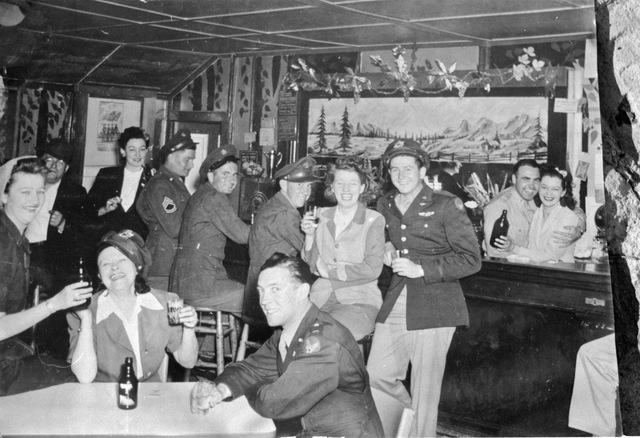By turn of century, Nevada towns began regulating red light districts
Editor’s note: This is the third in a series of stories by historian Bob McCracken on the history of prostitution in Nevada and Nye County. A new feature in the series will come out every Friday for the next several weeks.
When boom towns on the western frontier first sprang to life, there were seldom requirements regarding where prostitutes could practice their trade.
However, as communities grew and sex ratios equalized, prostitutes were subject to significant social ostracism. Laws were passed specifying where brothels could operate.
In Nevada, the Town Board Act of 1881 gave county commissioners the power to regulate brothels and curb prostitution in unincorporated communities.
Tonopah, Goldfield, Rhyolite, Manhattan, and other towns passed ordinances prescribing the location of red-light districts.
The sheriff and the district attorney were responsible for enforcing the regulations. Subsequent laws passed in 1887, 1889, and 1903 required minimum distances separating brothels from schools, churches, and main roads.
Tonopah had two red-light districts — one on St. Patrick’s and Central streets at the north end of town west of Main Street, and the other in the Corona Avenue area east of Main, also on Tonopah’s north end.
On February 28, 1915, the Nye County Commissioners were presented with a petition calling for closure of the Corona Avenue and vicinity portion of Tonopah’s tenderloin. The petition left alone the red-light area behind the Big Casino on St. Patrick and Central streets. The letter accompanying the petition is presented in full in the accompanying sidebar.
A grand jury is called
In early 1915, a grand jury was empanelled to investigate a number of matters relating to the public welfare and interests of Nye County citizens.
The topics investigated included gambling, public buildings — such as the courthouse, schoolhouses, the county hospital.
Among the topics to be addressed was the demand for closing Corona Avenue to “houses of ill fame.”
In its final report to Judge Mark R. Averill, Fifth Judicial District Court of the State of Nevada, released in January 1916, the grand jury was pleased to report that the Corona Avenue area had been closed to prostitution, “there being only one exception [Dolly McFranquelin], which is now in the courts as a test case and we trust the ordinance will be upheld by the courts.”
In 1915, Nye County commissioners passed Ordinance 32, outlawing brothels in the Corona Avenue red-light district. The law didn’t sit well with many, including Dolly McFranquelin, who operated a small brothel in the Corona district and resented the idea of having to move across Main Street to the St. Patrick Street area, where her activity would be legal.
She refused to move, was arrested and convicted, then appealed her case.
Dolly McFranquelin won her appeal in district court for her arrest under Ordinance 32. The ordinance was then modified and the county commissioners passed it as Ordinance 33.
Dolly was again arrested, convicted, and again won her appeal. This went on through several iterations, ending in Ordinance 36. In the end, prostitution was halted in the Corona Avenue red-light area. Thereafter, prostitution in Tonopah was confined to the St. Patrick Street area.
Regarding a Tonopah pimp
Pimps — that is to say, those who procure for and/or live off of the earnings of prostitutes — have never enjoyed much respect either on the western frontier or today.
Pimps frequently used physical abuse to maintain control over the women with whom they became enmeshed and whose earnings they confiscated in one way or another.
Unflattering portraits of pimps can be seen in the local newspapers of early Nye County.
In its Oct. 12, 1911 issue, the Tonopah Daily Bonanza presented a most negative portrait of a pimp named Harry Lightner.
The style in which the story was written utilizes the Sagebrush journalism style, which began in the Virginia City area following the discovery of the Comstock and where Mark Twain, perhaps America’s greatest author, once worked and perfected his own wonderful writing style.
The Tonopah Daily Bonanza reported that the “leech” Harry Lightner was in his “pug-ugly” mood “and wanted to whip somebody” (somebody who couldn’t fight back).
Lightner found Miss Vera and Miss Gladys in their rooms in one of the parlor houses, where he “pummeled both ladies to his heart’s content.” When Lightner had finished with his sport, Miss Vera, “his supposed wife,” swore out a complaint and wanted him assassinated right then and there.
“Oh, the brute!” she said.
She never wanted to see his face again and agreed to testify against him in justice court.
Lightner’s trial was set for two o’clock the next afternoon.
In the meantime, he had been released on $250 bail.
However, as the Daily Bonanza put it, “Evidently he had a talk with Miss Vera and she closed up like a clam.”
When the case was called in court, she was not there to testify against “the thing” that had beaten her and the case was dismissed.
Not put off by the matter, officers immediately swore out a complaint against Lightner as a vagrant.
Looking for love in Goldfield
Sally Zanjani, one of Nevada’s outstanding historians, has described how during the heydays of Goldfield, marriage- eligible women would come to the boom town in search of a husband.
Among such women, the search for a mate was systematic, with the lady having clearly in mind the minimum requirements a prospective husband candidate must meet, with financial prosperity high on the list.
On other occasions, a woman might just be marking time, perhaps building her cash reserve working in the tenderloin.
As an example of the latter, Zanjani tells a story from Goldfield’s red-light district.
Frank Crampton, the scion of a wealthy and socially prominent family, was in search of adventure when he landed in Goldfield in 1906.
He soon became deeply enmeshed with a prostitute. Zanjani says the woman declined to talk about her background with him, but “apparently found a great many other things to discuss.”
She says he well understood that upon his departure she would pull up the shade in the window of her crib and stand waiting for the next customer.
It wasn’t long before Crampton was spending a good deal of time with the woman. Moreover, he was paying her twice her customary price.
This went on for weeks, until one evening he arrived at her crib to find “another soiled dove” in her place.
The woman he was expecting to see had vanished.
Crampton came down with pneumonia that winter and was taken to Oakland, California, to recuperate.
There, as he got stronger, he was invited to make appearances at social engagements put on by his aunts. At one such affair, “he was astonished to meet a beautifully garbed society matron and mother of three children” whom he had last seen at her Goldfield crib — “the girl from Goldfield.”
It seems the woman’s husband had been accused of embezzlement and she had deserted him for a while, then returned when his finances were in better shape.
In his own book, Crampton describes seeing the lady at his aunt’s New Year’s Eve ball in 1906.
He wrote, “And then it came time for the old and new year dance. It was the same as the one before, excepting that I held her tighter, and she rested her arm on my shoulder a little heavier. Our hands held each other’s more firmly and once in a while there was pressure from one to the other.”
Zanjani notes that Crampton left Goldfield, preferring to forget the memories of the love he had enjoyed at the crib in that great boom town.
















